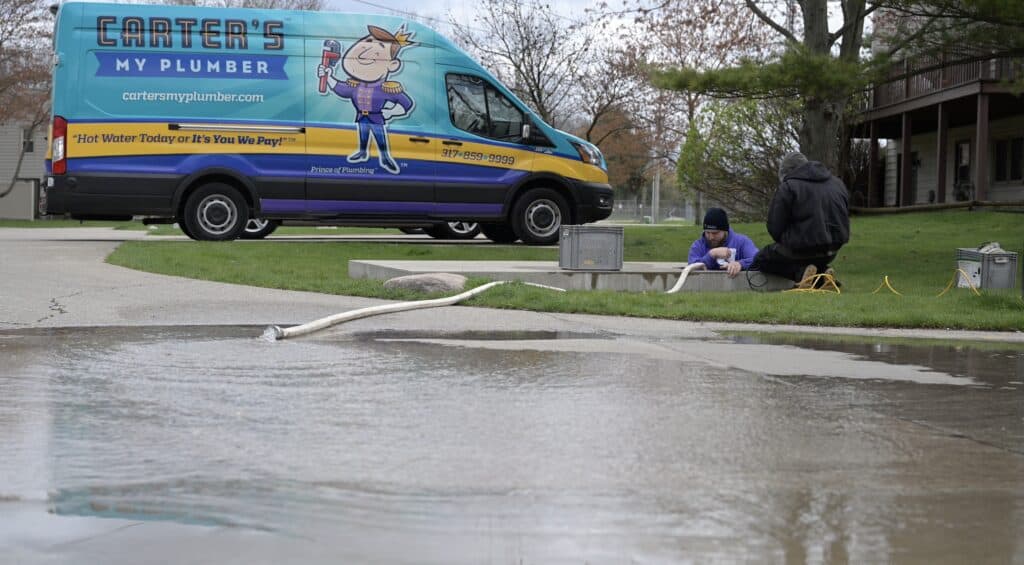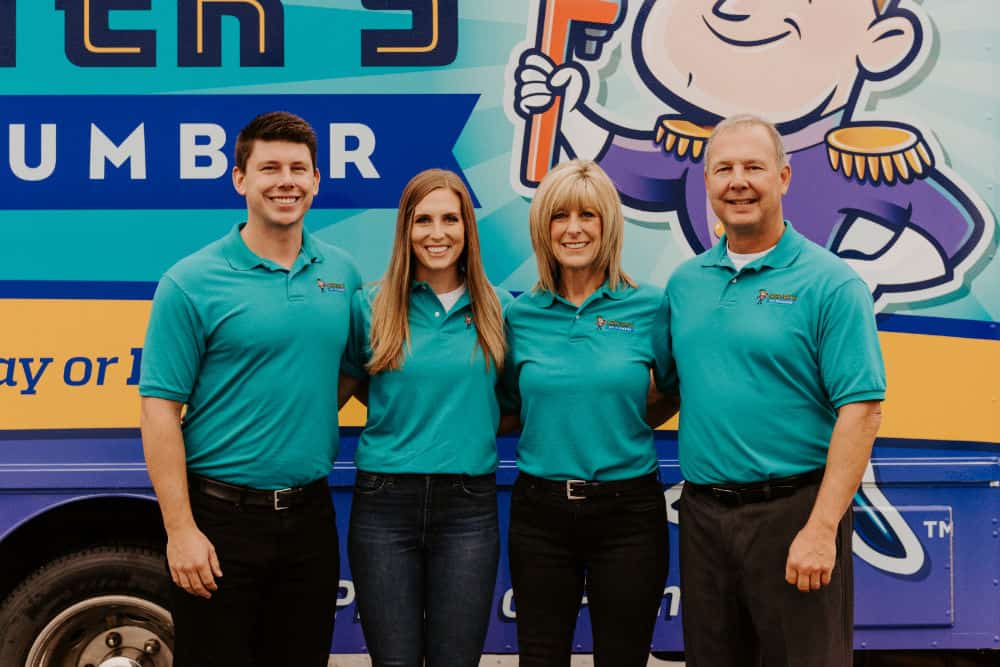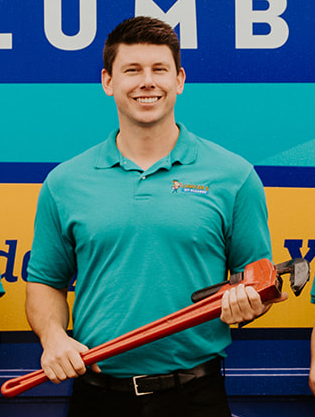Table of Contents
A broken sewer pipe is more than just a minor plumbing issue–it can lead to foul odors, persistent leaks, and even structural damage if left unchecked. Homeowners may first notice slow drains, wet spots in the yard, or an unexplained spike in their water bill, all of which can signal a problem with the sewer line.
Cracks in sewer pipes can develop due to aging materials, ground shifting, extreme temperature changes, or invasive tree roots seeking moisture. While some small cracks can be temporarily patched, more extensive damage often requires professional repair.
This guide will walk you through the steps to identify, temporarily fix, and permanently repair a cracked sewer pipe. We’ll also discuss when it’s best to call in an expert. If you’re facing a sewer pipe issue, Carter’s My Plumber is here to help as a trusted Indianapolis sewer line repair company.

Identifying a Cracked Sewer Pipe
A cracked sewer pipe can cause major disruptions in your home, but early detection can prevent costly repairs.
Watch for these common signs:
- Foul odors: The smell of sewage inside or outside your home may indicate a pipe leak.
- Slow drains or backups: If multiple drains are clogging frequently, a cracked pipe could be allowing debris buildup.
- Wet spots or sinkholes: Unexplained pooling water or sinking areas in your yard may signal a leak underground.
- Higher water bills: A sudden spoke in your water bill could mean wastewater is escaping from a cracked sewer line.
A variety of reasons can lead to sewer line issues, including:
- Aging cast iron pipes: Older pipes, especially clay or cast iron, become brittle over time.
- Tree roots: Roots natural seek out moisture and can infiltrate small pipe cracks, worsening the damage.
- Ground movement: Shifting soil, heavy traffic above the pipe, or freezing temperatures can cause pipes to crack or misalign.
Identifying these warning signals early can help you take action before the problem worsens.
Temporary Fixes for a Broken Sewer Pipe
If you discover a cracked sewer pipe, a temporary fix can help prevent further damage while you arrange for a professional plumber to repair it. For small cracks, applying epoxy or plumber’s putty can create a quick seal to stop leaks. These materials are water-resistant and can hold up for a short period, but they are not a permanent solution.
Another option is using a pipe wrap or rubber couplings to contain leaks. Pipe wraps are designed to reinforce weakened sections of the pipe, while rubber couplings provide a tight seal around the damaged area. These temporary measures can help minimize water damage and odors until a professional plumber can assess the situation.
However, some cases require more than a quick fix. If the crack is large, sewage is backing up into your home, or the pipe is severely misaligned, a full repair or replacement is necessary. Ignoring the problem can lead to costly structural damage and health hazards, making professional intervention essential.
Permanent Repair Methods
When it comes to fixing a broken sewer pipe, permanent repairs are central for long-term functionality. There are two main types of repairs: excavation and trenchless methods.
Excavation Repair
- Process: Involves digging up the ground to access the damaged sewer pipe, then removing the broken section and replacing it with new piping.
- Pros: This method is highly effective for severe cracks or broken pipes, providing a permanent fix for extensive damage.
- Cons: Excavation can be disruptive, requiring significant digging that may affect landscaping, driveways, or foundations. It can also be costly due to the need for labor, equipment, and potential restoration work.
Trenchless Repair Methods
Trenchless technology has become popular due to its less invasive nature, offering efficient repair solutions for cracked sewer pipes without large-scale excavation.
Pipe Relining
- Process: A resin-coated liner is inserted into the existing pipe and expanded to seal cracks from the inside. The liner hardens over time, creating a new, durable pipe within the old one.
- Ideal for: Moderate damage where the pipe is still structurally sound but needs reinforcement.
- Benefits: No need for major excavation, saving time, cost, and disruption. The process is cleaner and typically faster than traditional excavation.
Pipe Bursting
- Process: This method involves breaking apart the damaged pipe with a special bursting head while simultaneously pulling a new pipe into place.
- Ideal for: Severely cracked or deteriorating pipes that require full replacement.
- Benefits: This method requires fewer access points, and the process is quicker than excavation. It also avoids the needs for large digging areas, preserving the landscape and reducing labor costs.
Each repair method has its advantages, depending on the severity of the damage and the location of the pipe. Consulting with a professional plumber is key to determining the most effective and cost-efficient approach.
When to Call a Professional Plumber
Sewer pipe repairs are complex and require specialized tools and expertise to avoid further damage and ensure lasting results. Attempting DIY repairs can lead to costly mistakes and worsening of the plumbing issue.
How Carter’s My Plumber can assist in Indianapolis:
- Camera Inspections: Our team uses advanced camera technology to accurately assess the damage and locate the source of the problem.
- Expert Repairs: Whether you need trenchless or excavation repairs, we have the skills and equipment to handle any sewer pipe issue.
- Fast, Reliable Service: As an Indianapolis sewer line repair company, we offer prompt and dependable service, guaranteeing your sewer pipe is fixed with minimal disruption.
Preventing Future Sewer Pipe Cracks
To prevent future sewer pipe cracks, regular maintenance is key. Scheduling annual sewer inspections helps identify potential issues before they become major problem. Additionally, taking steps to prevent tree root intrusion is critical–keeping large trees away from sewer lines will reduce the risk of roots causing cracks.
Proper usage of your plumbing system is also important; avoid flushing non-biodegradable items or pouring grease down drains, as this can lead to blockages and pipe damage.
Don’t Let a Cracked Pipe Drain Your Wallet
Fixing a cracked sewer pipe promptly is necessary to avoid further damage and expensive repairs. If you’re dealing with a cracked sewer pipe in Indianapolis, trust Carter’s My Plumber for fast, reliable, and expert solutions.
Contact us today to ensure your plumbing is in top shape!
FAQs
- Can a sewer pipe be repaired? Yes, sewer pipes can be repaired using methods like excavation, trenchless pipe relining, or pipe bursting depending on the severity of the damage.
- How do you fix a cracked pipe without replacing it? A cracked pipe can be fixed using temporary solutions like epoxy, plumber’s putty, or pipe wraps, though permanent repairs may require professional intervention.
- Does homeowners insurance cover sewer lines? Homeowners insurance typically does not cover sewer line repairs unless the damage is caused by a covered event, such as a sudden and accidental break.



